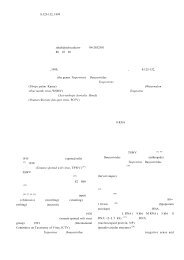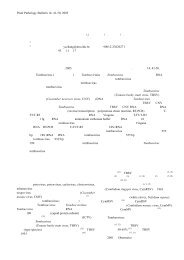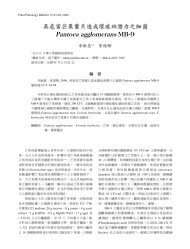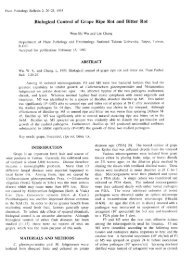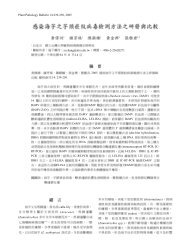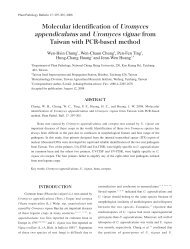Xanthomonas campestris pv. raphani
Xanthomonas campestris pv. raphani
Xanthomonas campestris pv. raphani
- No tags were found...
You also want an ePaper? Increase the reach of your titles
YUMPU automatically turns print PDFs into web optimized ePapers that Google loves.
Plant Pathology Bulletin 16: 87-90, 2007<strong>Xanthomonas</strong> <strong>campestris</strong> <strong>pv</strong>. <strong>raphani</strong>1, 2 1 1 112yfwu@mail.tndais.gov.tw +886-6-591290896 4 12. 2007.<strong>Xanthomonas</strong> <strong>campestris</strong> <strong>pv</strong>. <strong>raphani</strong>. 16 87-90.2004 2005 36CA25CA253CA25Biolog CA25 <strong>Xanthomonas</strong> <strong>campestris</strong> <strong>pv</strong>. <strong>raphani</strong><strong>Xanthomonas</strong> <strong>campestris</strong> <strong>pv</strong>. <strong>raphani</strong><strong>Xanthomonas</strong> <strong>campestris</strong> <strong>pv</strong>. <strong>campestris</strong> (Pammel)DowsonVV CA22 - CA36 15CA25CA25 36 - 102004 200536 (CA1-CA21 CA22-CA36) 10 8 cfu/ml0.2( )3 0.1 -1CA1-CA21 212 VV7CA25 20055 - 6nutrient agar (NA)BUGA (Biolog
8816 2 2007<strong>Xanthomonas</strong> <strong>campestris</strong> <strong>pv</strong>. <strong>raphani</strong> CA25 ( ) X. <strong>campestris</strong> <strong>pv</strong>. <strong>campestris</strong> XC435 ( )( 7 )Fig. 1. Symptoms on cabbage leaves inoculated with <strong>Xanthomonas</strong> <strong>campestris</strong> <strong>pv</strong>. <strong>raphani</strong> strain CA25 (left) and X.<strong>campestris</strong> <strong>pv</strong>. <strong>campestris</strong> strain XC435 (right) by the leaf margin clipping method (7 days after inoculation).universal growth agar) 3024 biolog inoculating fluidGN2 MicroplateBiolog(Microstation TM ID System)<strong>Xanthomonas</strong> <strong>campestris</strong> <strong>pv</strong>. <strong>raphani</strong> (SIM 0.84)(pathovar)X. <strong>campestris</strong>(bacterial leaf spot disease)(3)<strong>campestris</strong> <strong>pv</strong>. <strong>raphani</strong>1983-1986X. <strong>campestris</strong> <strong>pv</strong>. <strong>raphani</strong>(5) (2)X.X. <strong>campestris</strong> <strong>pv</strong>. armoraciae(Raphanus sativus)(Brassica rapa) (4)(3)(5)(2)CA25X. <strong>campestris</strong> <strong>pv</strong>. <strong>raphani</strong> (B.oleracea var. capitata B. oleracea var. acephala)(B. oleracea var. botrytis) B. oleracea var.gemmifera (B. juncea) (Lycopersiconesculentum)(Capsicum annuum)(Nicotiana tabacum) (Cucumis sativus)(Cucurbita moschata) Armoracia rusticanaLepidium sativum Nasturtium Capsella bursapastoris(Matthiola incana) (Phaseolusvulgaris) (Glycine max) garden huckleberry(Physalis sp.) (2 3 4) CA25<strong>Xanthomonas</strong> <strong>campestris</strong> <strong>pv</strong>. <strong>raphani</strong> CA25( ) X. <strong>campestris</strong> <strong>pv</strong>. <strong>campestris</strong> XC435 ( )( 7 )Fig. 2. Symptoms on Chinese cabbage leaves sprayinoculatedwith <strong>Xanthomonas</strong> <strong>campestris</strong> <strong>pv</strong>. <strong>raphani</strong>strain CA25 (left) and X. <strong>campestris</strong> <strong>pv</strong>. <strong>campestris</strong> strainXC435 (right) (7 days after inoculation).( ) ( )( 80 ) ( 701)( 909) ( )( ) ( 2 ) ( )( ) ( ) ( ) ( )( ) ( ) ( )3
<strong>Xanthomonas</strong> <strong>campestris</strong> <strong>pv</strong>. <strong>raphani</strong> 89CA25<strong>Xanthomonas</strong> <strong>campestris</strong>Table 1 A comparison of host range of strain CA25 with that of several pathovars of <strong>Xanthomonas</strong> <strong>campestris</strong>Host plant Strain CA25 X. <strong>campestris</strong> <strong>pv</strong>. <strong>raphani</strong> 2 X. <strong>campestris</strong> <strong>pv</strong>. <strong>campestris</strong> X. <strong>campestris</strong> <strong>pv</strong>. armoraciae 2Radish1VCabbageVChinesecabbageVCauliflowerVBroccoliVTomatoCucumberPumpkinStockSoybean1 : Leaf spot symptom; V: Vascular symptom; : No symptom2 Data from Tamura et al. (2) and Vicente et al. (3)0.1( )Vicente(nonvascular)X. <strong>campestris</strong> <strong>pv</strong>. <strong>raphani</strong> X. <strong>campestris</strong> <strong>pv</strong>.armoraciae (3)( ) CA25X. <strong>campestris</strong> <strong>pv</strong>. <strong>raphani</strong>1. Sahin, F., and Miller, S. A. 1997. A new pathotype of<strong>Xanthomonas</strong> <strong>campestris</strong> <strong>pv</strong>. armoraciae that causesbacterial leaf spot of radish. Plant Dis. 81:1334.2. Tamura, K., Takikawa, Y., Tsuyumu, S., and Goto, M.1994. Bacterial spot of crucifers caused by<strong>Xanthomonas</strong> <strong>campestris</strong> <strong>pv</strong>. <strong>raphani</strong>. Ann.Phytopathol. Soc. Jpn. 60:281-287.3. Vicente, J. G., Everett, B., and Roberts, S. J. 2006.Identification of isolates that cause a leaf spot diseaseof brassicas as <strong>Xanthomonas</strong> <strong>campestris</strong> <strong>pv</strong>. <strong>raphani</strong>and pathogenic and genetic comparison with relatedpathovars. Phytopathology 96:735-745.4. White, H. E. 1930. Bacterial spot of radish and turnip.Phytopathology 20:653-662.5. Zhao, Y., Damicone, J. P., Demerzas, D. H., Bender, C.L., and Zhao, Y. F. 2000. Bacterial leaf spot diseases ofleafy crucifers in Oklahoma caused by pathovars of<strong>Xanthomonas</strong> <strong>campestris</strong> . Plant Dis. 84:1008-1014.
9016 2 2007ABSTRACTWu, Y. F. 1 , S. C. Chen, S. H. Huang and A. S. Cheng 2 . 2007. First report of bacterial leaf spot diseaseof crucifers caused by <strong>Xanthomonas</strong> <strong>campestris</strong> <strong>pv</strong>. <strong>raphani</strong> in Taiwan. Plant Pathol. Bull. 16: 87-90.(Tainan District Agricultural Research and Extension Station, Council of Agriculture, ExecutiveYuan, 70, Muchang, Sinhua, Tainan, 71246, Taiwan; 1 Corresponding author: E-mail:yfwu@mail.tndais.gov.tw ; FAX: +886-6-5912908)Thirty six bacterial strains forming colonies characteristics of <strong>Xanthomonas</strong> <strong>campestris</strong> wereisolated from black rot-infected cabbage leaves in the cabbage growing areas in Yuinlin county during2004 and 2005. When these strains were inoculated by leaf edge clipping or leaf spraying method tocabbage (cv. K-Y cross) leaves, all strains except CA25 induced typical black rot symptoms. StrainCA25 caused spot lesions on cabbage leaves when spray-inoculated, and severe infection may resultin leaf curl, shrink and finally dry up, and if spots appeared on veins, they were oval with blackmargin; whereas slight curling and vein blackening at the cutting edge were observed when leaf edgeclip-inoculated, but these symptoms did not develop further. Strain CA25 also caused spot lesions onleaves of many crucifers, curcubits, tomato and soybean, but not on common stock (Matthiolaincana). Based on the host range test and the Biolog Microstation TM ID System, strain CA25 wasidentified as <strong>Xanthomonas</strong> <strong>campestris</strong> <strong>pv</strong>. <strong>raphani</strong>. This is the first report of this pathogen in Taiwan.



